‘Death Becomes Her’ Turns 25: Behind the Scenes of Its Oscar-Winning Special Effects
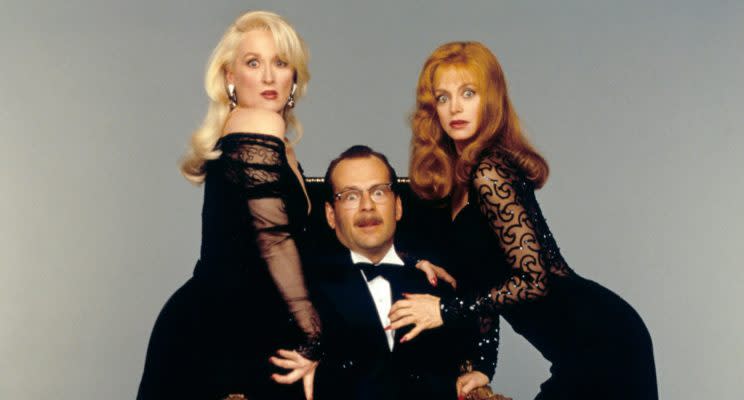
The black comedy Death Becomes Her, which has developed a healthy cult following since it opened 25 years ago, on July 31, 1992, is rarely cited as a special effects milestone. Yet Industrial Light and Magic’s work on Death Becomes Her, which won the movie its only Oscar, directly paved the way for the realistic dinosaurs in Jurassic Park, not to mention contemporary CG characters like Marvel’s Hulk.
For the film’s 25th anniversary, Yahoo Movies spoke with Death Becomes Her‘s visual effects art director Doug Chiang — then at the start of his career at ILM, now vice president and executive creative director at Lucasfilm — who explained how Meryl Streep’s 360-degree neck and Goldie Hawn’s torso-sized bullet wound revolutionized computer graphics.
Goldie Hawn and Meryl Streep compare macabre injuries in a scene from Death Becomes Her:
In Death Becomes Her, Hawn and Streep play ex-best friends turned middle-aged rivals, who discover a potion that can keep them eternally young. There is, however, a catch: their bodies cannot be killed, no matter how gruesomely they’re mangled and mutated. Thus, Streep’s character breaks her neck when she’s pushed down a flight of stairs, and spends the rest of the film putting her head back in place; Hawn’s character is shot, and spends the remainder of her scenes with a gaping hole in her stomach. All that said, Death Becomes Her is very much a comedy, so its body horrors are cartoonish enough to be funny — yet realistic enough that the audience stays engaged.
And that’s where the visual effects team came in. Thanks to director Robert Zemeckis’s determination to “push the boundaries of computer graphics,” as Chiang puts it, ILM took on the challenge of creating “organic CG” — in other words, making lifelike human skin and body parts with computer graphics. It sounds basic now, but in the early ‘90s, this was practically unprecedented.
Meryl Streep recovers from a fall in a scene from Death Becomes Her:
“Prior to Death Becomes Her, I worked on Terminator 2, and even though [the T-1000] looked kind of organic it was still synthetic: it was still metal, it was still robotic,” Chiang told Yahoo Movies. “Computer graphics at that time could do hard surfaces really well, like machinery. But Ken [Ralston, visual effects supervisor] and I knew that Bob Zemeckis wanted to play around with the human body, distorting proportions — breaking Meryl Streep’s neck, for instance, and other crazy things like that. In some ways, putting a very toony sensibility to it, but also making it very real and as believable as possible.”
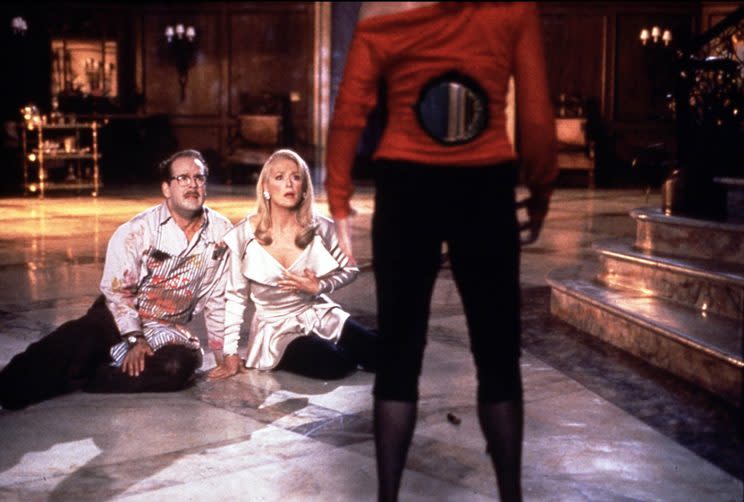
One of Chiang’s first tasks was to figure out just how realistic those effects should be. For example, with Hawn’s gaping shotgun wound, “I kind of played around with the whole range,” said Chiang. “The first version was very realistic: what would happen if a shotgun blasted your gut? So what I did was I did a very gruesome version where the hole wasn’t perfectly clean and round, you could actually see some of her internal organs and the spine.” Chiang laughed at the recollection, saying, “Right away, you could tell that that was going to be too much for the tone of this movie.” For the next version, the ILM artists decided to take “almost a Tex Avery approach” to Hawn’s injury. “And so I made the hole very graphic, very circular, and then maybe we don’t see the spine, and so literally you remove all the gruesome parts of it out of it, but at the same time you’re actually treating the quality of the hole in a very realistic manner. And that was the fine boundary that we were trying to find, in terms of designing computer visual effects that would fit with the tone of the movie without it becoming a horror movie.”
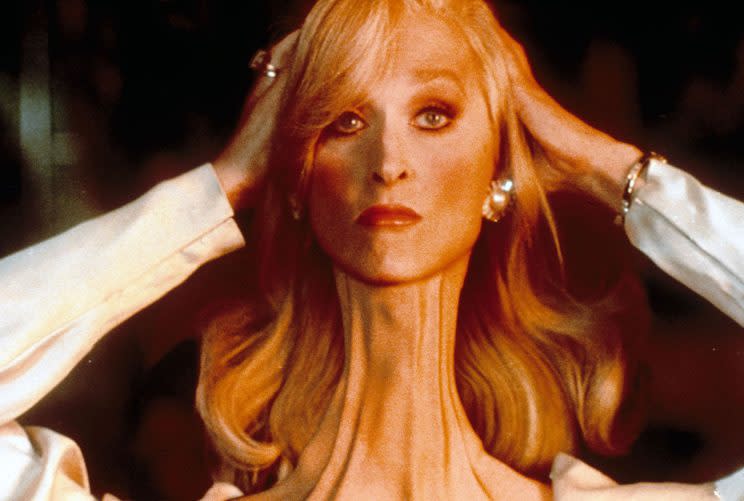
In order to get an accurate idea of how the effects would look, Chiang used a tool that was still very new to his industry: Photoshop. “Most of the art departments were still very traditional, in terms of pen and ink and markers,” said Chiang, who felt that his first colored-pencil sketches of Streep’s twisted neck didn’t capture the necessary detail. Instead, he scanned photographs of his art department colleagues, then digitally “painted” the effects on the photos. (See some of Chiang’s concept art, below.) By using Photoshop, said Chiang, “I could mimic with high fidelity the actual look that could be executed in computer graphics, in terms of the amount of highlights, the amount of wrinkles, how much bruising. And so it really transformed design to the next level; we were designing and creating imagery that looked very much like the finished product.”
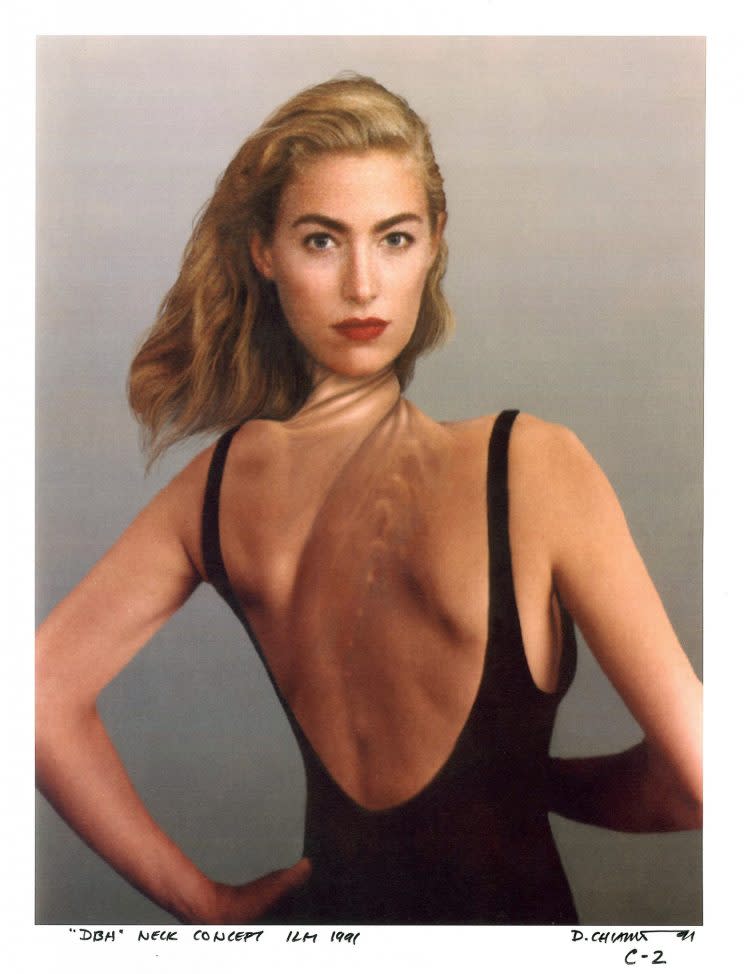

Some of the effects in Death Becomes Her were accomplished with makeup and prosthetics, but digital effects were used to create a seamless transition. For example, the film contains a famous shot in which Streep’s head and body are facing different directions. To accomplish that, Zemeckis shot the scene with Streep facing backwards. Then in postproduction, the actress came to ILM, where they filmed only her head performing the scene. (She was seated in a chair and wearing a blue bodysuit.) “A lot of those things involved shooting elements after the fact, and choreographing it very carefully so that her expressions matched her body poses,” said Chiang. “And it was a very delicate thing. In hindsight, it’s very, very complex, whereas today we would probably do most of that visually. But back then it was still old-school, because we were blending traditional techniques with the new tools that we had in computer graphics.”
Of the film’s “old school” effects, Chiang’s favorite is one that most contemporary audiences likely wouldn’t notice: the miniature sets. Nowadays, computer graphics are used to create larger worlds around small sets. But traditionally, this was accomplished with either realistic matte paintings (like the Emerald City in The Wizard of Oz) or extremely detailed miniatures (like the Tyrell building in Blade Runner). Chiang revealed that multiple sets in Death Becomes Her were built-to-scale miniatures, including the Gothic mansion where Isabella Rossellini dispenses her magical potion. Chiang has fond memories of crawling around the mansion, adjusting the lights on each tiny, individual room. (See photo below.)
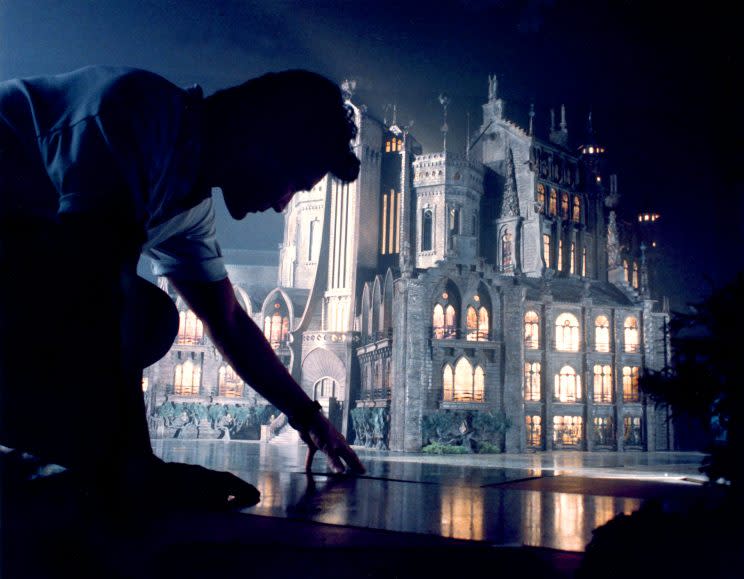
“For me the charm of Death Becomes Her was, it was really one of the films that bridged that technology gap,” Chiang said. On the threshold of the computer graphics revolution, ILM’s artists were literally “inventing the tools as we were making the movies,” he explained. “And often we would start projects without really knowing how we were going to do the effects.”
The realistic body effects that ILM created for Death Becomes Her proved that computer graphics could be used for more than just robots and machines. The results of that discovery can now be seen all over the multiplex, from the photorealistic apes in War for the Planet of the Apes to the de-aged Kurt Russell in Guardians of the Galaxy Vol. 2. Just remember: It all started with Meryl Streep falling down a flight of stairs.
Rogue One behind the scenes — Doug Chiang starts development:
Read more from Yahoo Movies:


